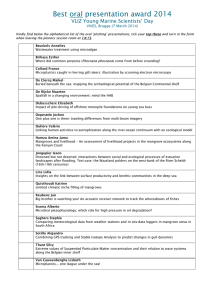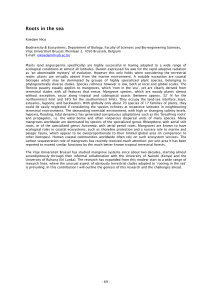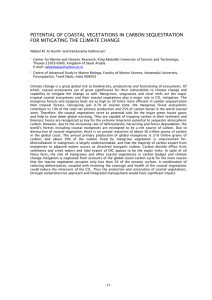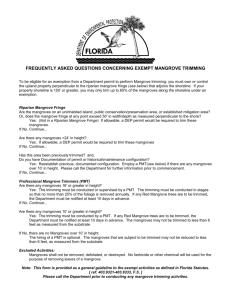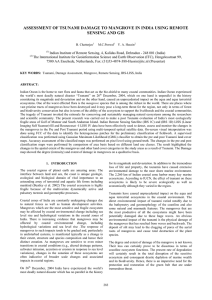I & Biological Populations
advertisement
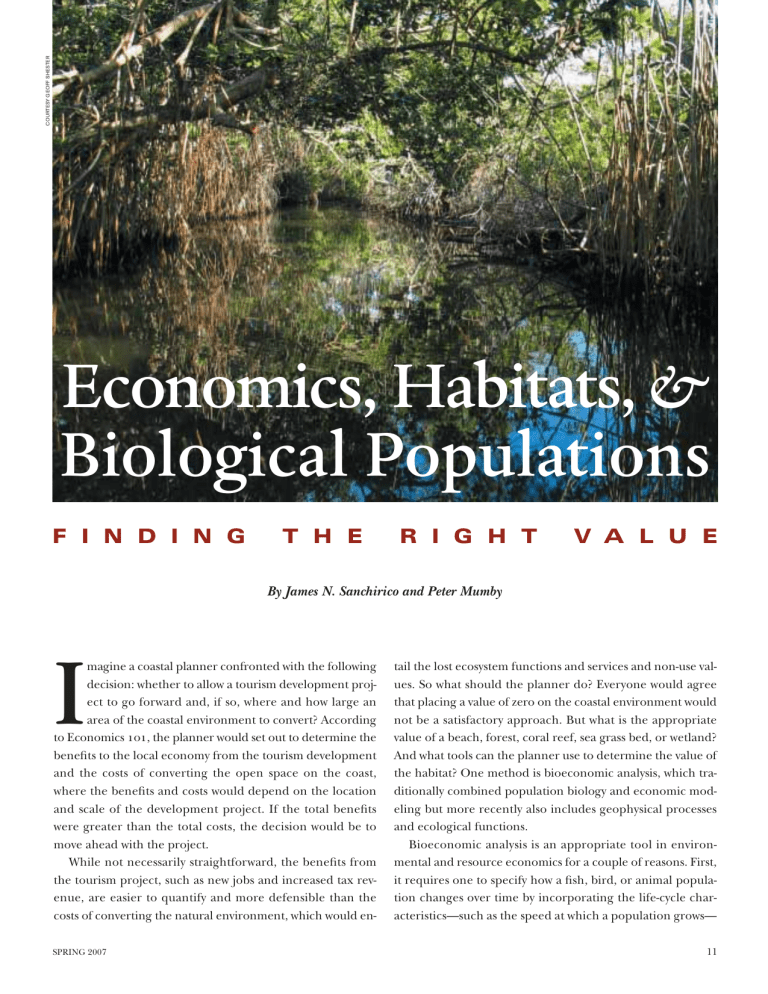
COURTESY GEOFF SHESTER Economics, Habitats, & Biological Populations F I N D I N G T H E R I G H T V A L U E By James N. Sanchirico and Peter Mumby I magine a coastal planner confronted with the following decision: whether to allow a tourism development project to go forward and, if so, where and how large an area of the coastal environment to convert? According to Economics 101, the planner would set out to determine the benefits to the local economy from the tourism development and the costs of converting the open space on the coast, where the benefits and costs would depend on the location and scale of the development project. If the total benefits were greater than the total costs, the decision would be to move ahead with the project. While not necessarily straightforward, the benefits from the tourism project, such as new jobs and increased tax revenue, are easier to quantify and more defensible than the costs of converting the natural environment, which would en- SPRING 2007 tail the lost ecosystem functions and services and non-use values. So what should the planner do? Everyone would agree that placing a value of zero on the coastal environment would not be a satisfactory approach. But what is the appropriate value of a beach, forest, coral reef, sea grass bed, or wetland? And what tools can the planner use to determine the value of the habitat? One method is bioeconomic analysis, which traditionally combined population biology and economic modeling but more recently also includes geophysical processes and ecological functions. Bioeconomic analysis is an appropriate tool in environmental and resource economics for a couple of reasons. First, it requires one to specify how a fish, bird, or animal population changes over time by incorporating the life-cycle characteristics—such as the speed at which a population grows— 11 COURTESY K. HOLMES show this benefit, such as of the species under considsnapper and parrotfish, aperation. Second, the costs parently hide in the root and benefits either from structure of the mangroves harvesting the species or during their juvenile stage from nonconsumptive uses to avoid predators. This or both can be explicitly acrefuge allows them to grow counted for. Putting these to a size such that when they parts together in one Coastal mangroves above water. migrate to the coral reef in framework permits an analyst to understand the full economic and ecological trade-offs their adult stage they can escape predators on the reefs. How can we capture the production value of the mangrove involved in managing animal populations. For example, sustaining larger populations comes at the cost of lower levels of habitat to help inform the coastal planner of what the costs of extraction; bioeconomic analysis can help shed light on what conversion are? From an economist’s perspective, the manthe benefits and costs are for different population sizes, given groves are similar to the machines and other inputs that prothe goals of the resource manager and society more generally. duce economic outputs (here the coral reef fish). Unlike labor, where there is a market to determine the going wage rate, no market exists for this ecosystem function. We can, however, Valuing Mangrove Habitat calculate the value of the mangroves by incorporating their To set the coastal planner’s problems in a more specific con- role in species population dynamics. That is, we can use biotext, we can use the example of coastal mangroves to show economic analysis to investigate the difference in the value of what bioeconomic analysis can contribute. Coastal man- a fishery with and without the mangroves present. Our findings show that for any number of fishing boats groves are intertidal forests located throughout tropical regions around the world (see photographs). Current estimates and fishermen, the profits from fishing are greater with the are that between 35 and 50 percent of mangroves worldwide mangroves present than without them. This benefit results have already been lost, with current deforestation rates from the greater abundance of fish that are protected from greater than those of tropical rainforests. The primary predators by the refuge in nearby mangroves. Another inthreats to these systems are coastal development and con- teresting implication of having coastal mangroves in the version to shrimp aquaculture. One reason why mangroves vicinity of the coral reefs is that the fishery can support are threatened is that the economic value of the harvestable greater levels of fishing effort than without the mangroves. products, like wood, and the “services” they provide, includ- We can measure the value of the mangrove or “mangrove efing hurricane and tsunami protection, have not been prop- fect” by simply calculating the difference between fishing profits with and without mangroves present. erly determined and considered in the clearing decision. The size of the mangrove effect depends in some comHere, we will focus on just one function, the role of mangroves in the “production” of coral reef fish species. Some ex- plicated ways on ecology, economics, and governance—how citing new scientific studies have shown that coral reefs in the fishery is managed. On the ecological side, what matters close proximity to mangrove habitats exhibit larger abun- is how the species utilize different habitats in their life cycle dances of some species and greater biodiversity. Species that and where the fish are subject to the greatest levels of pre12 RESOURCES COURTESY K. HOLMES mangrove is so high in this dation. On the economic particular location that no side, the size of the mandevelopment project of any grove effect depends on the size is initiated. price of the fish and the Again, the size of the costs of fishing. For examproject that just balances ple, the higher the price or the benefits and costs with lower the fishing costs, the and without considering the greater the value, holding Coastal mangroves below water. mangroves will depend, in all else the same. In terms of governance, the potential value depends on how many part, on the same factors that lead to greater fishing profits. fishing vessels are permitted to fish and the nature of their That is, it depends in non-trivial ways on the economics, ecolrights to the total catch. If local fishery managers do not im- ogy, and governance. As a tool for helping policymakers and regulators underplement rights-based tools, such as a harvesting cooperative or individual fishing quota system, then there might not be stand the value of ecological functions and the value of the any value to the fishery from the mangroves. The important services provided by habitats, such as wetlands, forests, coral role of governance and institutions in determining the value reefs, mangroves, and by biological populations, bioecoof ecosystem services is a point often lost in discussions on nomic analysis is well developed and perfectly suited for such demands. Modeling tools by their very nature, however, are the provision of these services. part science and part art. Therefore, we recommend using such analysis as a means to inform the policy process, not as Balancing Costs and Benefits a blunt metric yielding a “yes or no” answer. Currently, academia, government, and NGO communiLet’s return to our coastal planner. How might he or she use this information? In addition to the costs of converting the ties are discussing the need for interdisciplinary approaches mangroves in terms of lost storm protection, lost non-use val- to help address some of the more difficult conservation deues, etc., we can add in the costs resulting from the reduced cisions we are facing in the 21st century, including valuing profits from fishing the species that depend on them. In ecosystem functions and services and setting up private and other words, the larger the development project (in terms of public payment systems for these services. Since its origins the number of hectares of mangroves converted), the greater in the late 19th century and its blossoming in the middle of the opportunity costs of converting the mangroves. Together the 20th century, bioeconomic analysis has been and will these are the economic costs of the development project. continue to be an important tool for determining the value On the other hand, there are benefits to the development to society of biological populations and habitats—and one project. Balancing the costs and benefits, we can determine that is interdisciplinary at its core. ■ the efficient size and location of the project. We find that when the coastal planner ignores the value of the mangroves to the fishery, the size of the development project is larger and possibly in the wrong location. It could also be the case that the opportunity cost of clearing the first hectare of the SPRING 2007 13
